| A P P E N D I X E |
|
Options for Experienced Users |
This chapter provides experienced users information about other Sun StorageTek Common Array Manager tools and installation options. It contains the following sections:
The recommended software installation in Chapter 2 did not detail all installation options. This section provides more information about these options, including GUI installer steps. CLI installation information can be found in the section Installing and Configuring the CAM Software Using the CLI.
This section contains the following topics:
This install option creates a management station that contains the full set of CAM services:
The full install can either be installed locally on a data host connected to the array or on a central management server that communicates with the array via a proxy agent.
To install CAM with the Typical installation option, follow the procedure in the section Installing a Full Version of CAM on a Central Management Server or a Data Host, within Chapter 2.
Available from the Custom installation menu, this feature bundle creates a management station that contains the full set of CAM services, with the option to install the browser GUI interface. It can be installed locally on a data host connected to the array or on a central management server that communicates with the array via a proxy agent. It contains:
During installation, you will be prompted to select the arrays installed for your site and the corresponding firmware.
1. Start the installation using the steps for your OS.
a. Open a shell or terminal window.
b. Go to the directory containing the software you extracted.
c. Become superuser by typing su.
The Welcome panel appears. Go to Step 2 to continue.
a. Open a shell or terminal window.
b. Go to the directory containing the software you extracted.
c. Run the RunMe.bin script using the pfexec(1) command:
| Note - You must have the appropriate profile rights to run the pfexec(1) command. |
The Welcome panel appears. Go to Step 2 to continue.
Prerequisite: You must have Windows OS Administrator privileges to install the software.
a. Open the folder containing the extracted software.
b. Double-click the RunMe.bat icon.
The Welcome panel appears. Go to Step 2 to continue.
2. From the Welcome panel, click Next.
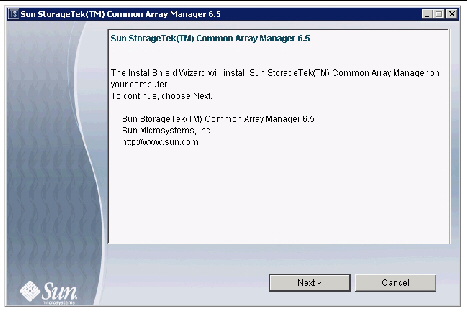
3. Accept the license agreement and click Next.
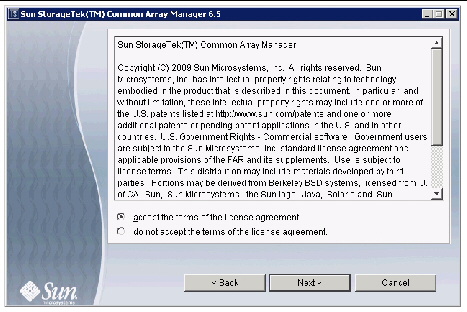
4. Choose Custom to reveal other installation options.
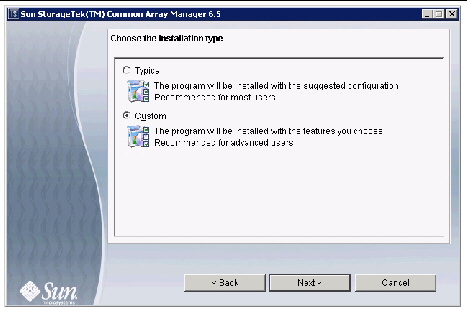
5. Click Next to proceed to the next step.
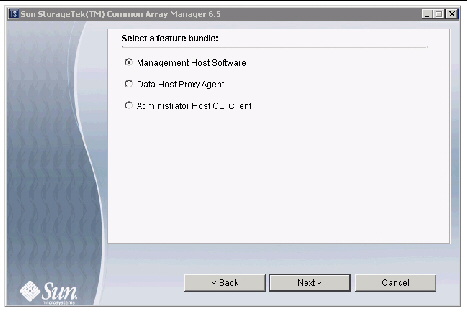
6. Select Management Host Software.
7. Click the Next button to proceed.
The following menu will appear:

8. Select the array types installed at your site, then select whether or not to install the browser GUI interface.
Select Storage Expansion Array if you have Sun JBOD arrays (e.g. J4500) installed at your site. Select RAID Array if you have Sun arrays with RAID controllers (e.g. 6540) installed at your site.
9. Click next to display the Review Selections screen.
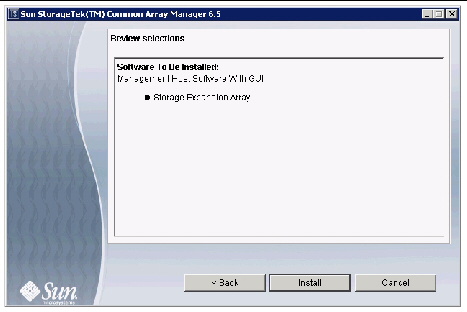
10. To continue, click the Install button.
| Note - During the software installation, the progress indicator reflects 0% for a significant portion of the installation process. |
When the installation is complete, the View Results screen is displayed.
For information on installation logs, refer to Reviewing the Installation Logs.
11. If you have no other CAM installations, eject the DVD.
12. Configure the firewall on the data host.
Set the firewall to allow an exception for port 6789.
Since a proxy agent was not installed or activated with this installation option, there is no need to open port 8653.
Some firewall programs prompt for your agreement to allow new programs to communicate through the firewall, and set the port for you. Refer to your firewall documentation for instructions on how to open a port through the firewall.
Available from the Custom installation menu, this feature bundle creates a compact, standalone installation which can be as little as 25mb in size. It installs all CAM core packages on a data host attached to the array, automatically installs storage expansion (i.e. JBOD) array packages, and allows management of devices via the CLI. This option includes:
With this option, a host can act as a proxy for the management host (this allows aggregation of information from multiple hosts as well as delegation to other hosts for firmware upgrades, access configuration changes, etc.).
FIGURE E-1 shows the Data Host Proxy Agent option installed on a data host that is also acting as a management host.
FIGURE E-1 Using the Data Host Proxy Agent Option to Manage the Array
|
Data Host with Data Host Proxy Agent installation and data to store |
|

During installation, you will have the option to enable remote access to the array via a proxy agent. The proxy agent receives out-of band communication from the management software over Ethernet and delivers the information over an in-band connection between the data host and the array. Access is over HTTPS and port 8653.
If remote access is enabled, you will need to choose an access password (15 characters maximum). Be sure to remember this password, as it will be needed during array registration.
| Note - Do not enable remote access if the management host is directly connected to the array. |
1. Start the installation using the steps for your OS.
a. Open a shell or terminal window.
b. Go to the directory containing the software you extracted.
c. Become superuser by typing su.
The Welcome panel appears. Go to Step 2 to continue.
a. Open a shell or terminal window.
b. Go to the directory containing the software you extracted.
c. Run the RunMe.bin script using the pfexec(1) command:
| Note - You must have the appropriate profile rights to run the pfexec(1) command. |
The Welcome panel appears. Go to Step 2 to continue.
Prerequisite: You must have Windows OS Administrator privileges to install the software.
a. Open the folder containing the extracted software.
b. Double-click the RunMe.bat icon.
The Welcome panel appears. Go to Step 2 to continue.
2. From the Welcome panel, click Next.
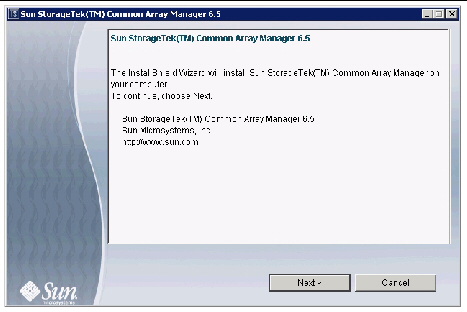
3. Accept the license agreement and click Next.
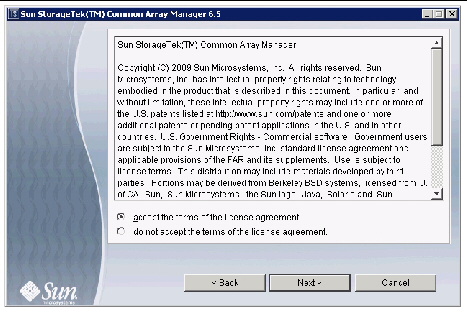
4. Choose Custom to reveal other installation options.
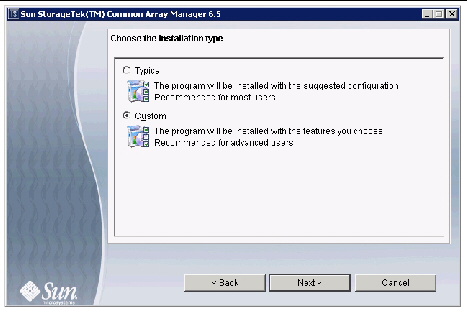
5. Click Next and proceed to the next step.

6. Select Data Host Proxy Agent to install the proxy agent on the data host.
| Note - The other options are explained in Appendix E, but are not needed by new users using the recommended installation. |
7. Click the Next button to proceed.
The following menu will appear:
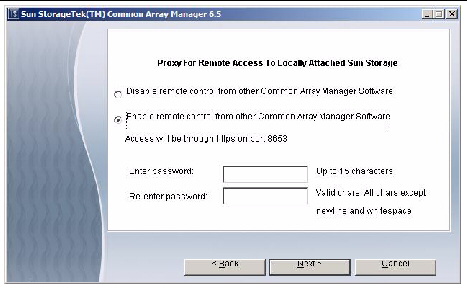
8. Select whether to enable or disable remote access.
Enabling remote access via proxy will allow remote control of locally attached storage from Common Array Manager software installed on other machines. If you choose to enable this option, you must supply an access password as directed. Do not activate the proxy if the management host is directly connected to the array.
| Note - Be sure to remember the access password. You will need to enter the proxy agent password when registering the array. |
9. Click next to display the Review Selections screen.
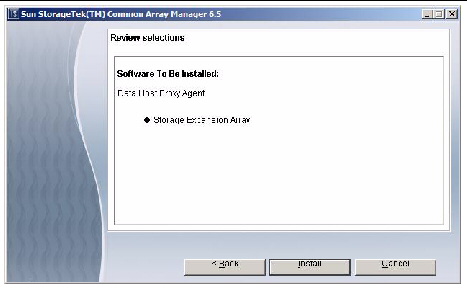
10. Review your selections and click Install.
| Note - During the software installation, the progress indicator reflects 0% for a significant portion of the installation process. |
When the installation is complete, the View Results screen is displayed.
For information on installation logs, refer to Reviewing the Installation Logs.
11. If you have no other CAM installations, eject the DVD.
12. Configure the firewall on both the management host and the data host.
Set the firewall to allow an exception for port 6789. If you have a proxy agent, also allow an exception to port 8653. Some firewall programs prompt for your agreement to allow new programs to communicate through the firewall, and set the port for you. Refer to your firewall documentation for instructions on how to open a port through the firewall.
Solaris OS 10 update 6 restricts port 6789 to listen to localhost only. To change this setting and enable remote access to the Java Web Console and CAM, do the following:
1. Become superuser or assume an equivalent role on the system where the console is running.
Roles contain authorizations and privileged commands. For more information about roles, see Configuring RBAC (Task Map) in System Administration Guide: Security Services:
http://docs.sun.com/app/docs/doc/816-4557/rbactask-15?a=view
2. Set a property to allow the console server to respond to network requests, refresh the service, and restart the console server.
# svccfg -s svc:/system/webconsole setprop options/tcp_listen=true # svcadm refresh svc:/system/webconsole:console # /usr/sbin/smcwebserver restart
Available from the Custom installation menu, this feature bundle installs a thin scripting client that connects via secure HTTP (HTTPS) to the management host (CLI only). The remote CLI is used to communicate with a host that has CAM core software installed.
See the Sun StorageTek Common Array Manager Software Release Notes for a list of supported operating systems for the client.
To install CAM with the Administrator Host CLI Client option, do the following:
1. Start the installation using the steps for your OS.
a. Open a shell or terminal window.
b. Go to the directory containing the software you extracted.
c. Become superuser by typing su.
The Welcome panel appears. Go to Step 2 to continue.
a. Open a shell or terminal window.
b. Go to the directory containing the software you extracted.
c. Run the RunMe.bin script using the pfexec(1) command:
| Note - You must have the appropriate profile rights to run the pfexec(1) command. |
The Welcome panel appears. Go to Step 2 to continue.
Prerequisite: You must have Windows OS Administrator privileges to install the software.
a. Open the folder containing the extracted software.
b. Double-click the RunMe.bat icon.
The Welcome panel appears. Go to Step 2 to continue.
2. From the Welcome panel, click Next.
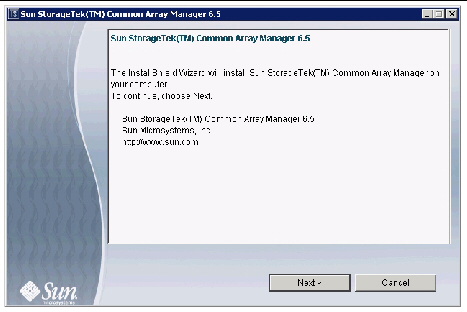
3. Accept the license agreement and click Next.
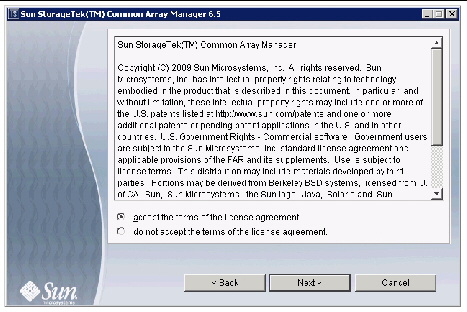
4. Choose Custom to reveal other installation options.
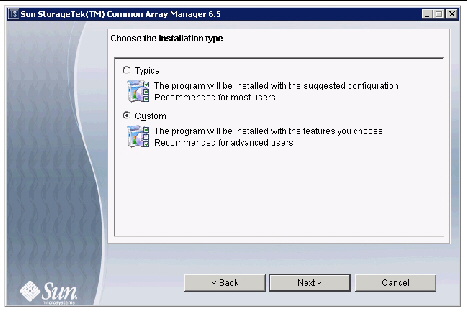
5. Click Next to proceed to the next step.

6. Select Administrator Host CLI Client.
7. Click next to display the Review Selections screen.

8. To continue, click the Install button.
| Note - During the software installation, the progress indicator reflects 0% for a significant portion of the installation process. |
When the installation is complete, the View Results screen is displayed.
For information on installation logs, refer to Reviewing the Installation Logs.
9. If you have no other CAM installations, eject the DVD.
10. Configure the firewall on administrator host and management host.
Set the firewall to allow an exception for ports 6789 and 8653.
Some firewall programs prompt for your agreement to allow new programs to communicate through the firewall and set the port for you. Refer to your firewall documentation for instructions on how to open a port through the firewall.
The following table lists the core software packages installed with the Custom installation options.
The following table lists the plug-in software packages installed with the Custom installation options.
The following tables show the location of the files and logs for the Sun StorageTek Common Array Manager software by operating system.
/var/opt/CommonArrayManager/Host_Software_6.x.x.x/bin |
|
/var/sadm/install/se6000 |
|
TABLE E-6 summarizes the commands you need to install the management software using either a GUI wizard or a CLI script.
If you are using the Solaris OS or Linux operating system and a path is not defined, use ./ to run the commands (./RunMe.bin).
If you are using a Windows platform, if the command alone does not work, add .\ to run the commands (.\RunMe.bat).
The CLI performs the same control and monitoring functions available through the browser interface. It is the interface for scripting tasks.
There are two forms of the CLI:
The only difference is that the local CLI requires a user to run the command as administrator from a shell on the management host. Because of this limitation, the login and logout commands aren’t supported.
Both CLIs can manage any array that has been registered and added to the Common Array Manager inventory in the same way that the browser interface can manage any array in the inventory. The array type and array management path (in-band, out-of-band, proxy agents) has no limitations with local or remote CLI usage. Both CLIs manage the same arrays with the same command set.
The following explains how to log in to and out of a the management host using the CLI. The options for accessing the CLI are presented in the next section.
There are different CLI directories for the remote and local CLIs.
1. Access the local CLI directory:
2. Access the remote CLI directory:
3. Log into the remote CLI by typing the following command:
% sscs login -h cam-hostname -u username
| Note - The Local CLI on a data host does not require the login command. You will need the terminal window login to the host. |
You can now use CLI commands to perform the same software operations as those available in the browser interface.
For more information about CLI commands, see:
| Note - To locate the sscs(1M) man page, you must update your MANPATH variable or use the -m option with the man command. |
4. Log out by typing the following command:
The local and remote CLIs can be accessed remotely through the full management workstation using:
Navigate to the Local CLI directory to manage the arrays via the proxy agent.
This thin scripting client uses HTTPS to communicate with the management host. Login to the management host and navigate to the Local CLI directory to manage the arrays via the proxy agent.
Login to the management host and navigate to the Local CLI directory to manage the arrays via the proxy agent.
This section describes how to install the management software using a command line interface script and other options for experience users. It contains the following sections:
You can install the Common Array Manager software on a SPARC, X86, or X64 system running the Solaris Operating System or OpenSolaris.
The array installation files and installers are provided in a compressed .bin file on the DVD.
The process unpacks the contents of the file on the host and then proceeds with the installation.
Before you continue, check that all of the requirements are met, as listed in Checking the Installation Requirements.
You can install from a DVD or from a download of the install files from the Sun Software Download Center. If installing from a download, run tar xvf filename to unpack the file, then change to the Host_Software_6.x.x.x directory and begin the following procedure at Step 3.
2. Insert the host software installation DVD into a drive on the management host.
If the compressed installation file does not appear in a directory window:
a. Change to the /cdrom/cdrom0 directory:
b. Display the contents of the DVD:
3. Review the README.txt file for the latest information on the product and the installation process.
4. To unpack the contents of the compressed installation file, enter the following command:
The files are unpacked in the default directory:
The Host_Software_6.x.x.x directory is unpacked into the default directory. To use a different directory, enter the following command:
RunMe.bin -c /path-to-new-directory
After a few moments, an InstallShield note will briefly display, then the software installer will begin automatically.
5. When prompted to proceed, press 1 for Next.
6. When prompted about the license agreement, read and accept the agreement by pressing 1 then Enter to select, 0 then Enter to confirm, and 1 then Enter to proceed.
7. When prompted to select the installation type, do one of the following:
If you select Custom, you will be prompted to choose:
These options are described in detail in the section Common Array Manager Installation Options.
8. Continue following the prompts to install the software.
When the installation is complete, the software installer Installation Summary screen is displayed.
9. Press Return to complete the installation.
10. Eject the DVD and remove it from the drive.
11. Configure the firewall on the management host, data host, and administrator host (if applicable).
Set the firewall to allow an exception for port 6789. If you have a proxy agent or CLI-only installation, also allow an exception to port 8653.
Some firewall programs prompt for your agreement to allow new programs to communicate through the firewall and set the port for you. Refer to your firewall documentation for instructions on how to open a port through the firewall.
You can use a CLI script to install the Common Array Manager software with the same options as the GUI install wizard on a host system running the Red Hat or SUSE Linux Operating System.
The array installation files and installers are provided in a compressed .bin file on the DVD.
The process unpacks the contents of the file on the host and then proceeds with the installation.
Before you continue, check that all of the requirements are met, as listed in Checking the Installation Requirements.
You can install from a DVD or from a download of the install files from the Sun Software Download Center. If installing from a download, run tar xvf filename to unpack the file, then change to the Host_Software_6.x.x.x directory and begin the following procedure at Step 3.
1. Log in to the management host Linux OS as root.
2. Insert the host software installation DVD into a drive on the management host.
If the compressed installation file does not appear in a directory window:
a. Change to the /media/cdrom directory:
cd /media/cdrom
b. Display the contents of the DVD:
3. Review the README.txt file for the latest information on the product and the installation process.
4. To unpack the contents of the compressed installation file, enter the following command:
The files are unpacked in the default directory: /var/opt/CommonArrayManager/Host_Software_6.x.x.x
The Host_Software_6.x.x.x directory is unpacked into the default directory. To use a different directory, enter the following command:
RunMe.bin -c /path-to-new-directory
After a few moments, an InstallShield note will briefly display, then the software installer will begin automatically.
5. When prompted to proceed, press 1 for Next.
6. When prompted about the license agreement, read and accept the agreement by pressing 1 then Enter to select, 0 then Enter to confirm, and 1 then Enter to proceed.
7. When prompted to select the installation type, do one of the following:
If you select Custom, you will be prompted to choose:
These options are described in detail in the section Common Array Manager Installation Options.
8. Continue following the prompts to install the software.
When the installation is complete, the host software installer Installation Summary screen is displayed.
9. Press Return to complete the installation.
10. Eject the DVD and remove it from the drive.
11. Configure the firewall on the management host, data host, and administrator host (if applicable).
Set the firewall to allow an exception for port 6789. If you have a proxy agent or CLI-only installation, also allow an exception to port 8653.
Some firewall programs prompt for your agreement to allow new programs to communicate through the firewall and set the port for you. Refer to your firewall documentation for instructions on how to open a port through the firewall.
You can use a CLI script to install the Common Array Manager software with the same options as the GUI install wizard on a system running Windows 2000, 2003, or XP.
The array installation files and installers are provided in a compressed file on the DVD. The process unpacks the contents of the file on the host and then proceeds with the installation.
Before you continue, check that all of the requirements are met, as listed in Checking the Installation Requirements.
1. Log into Windows as Administrator.
2. Insert the host software installation DVD into a local drive.
If the compressed installation file does not appear in a directory window, access the DVD drive (example: D:).
3. Review the README.txt file for the latest information on the product and the installation process.
4. To unpack the contents of the compressed installation file in the default directory, enter the following command:
RunMe.bat -c
After a few moments, an InstallShield window will briefly display, then the software installer will begin automatically. NOTE: The files are unpacked in the default directory:
<system drive>:\Sun\CommonArrayManager\Host_Software_6.x.x.x
5. When prompted to proceed, press 1 for Next.
6. When prompted about the license agreement, read and accept the agreement by pressing 1 then Enter to select, 0 then Enter to confirm, and 1 then Enter to proceed.
7. When prompted to select the installation type, do one of the following:
If you select Custom, you will be prompted to choose:
These options are described in detail in the section Common Array Manager Installation Options.
8. Continue following the prompts to install the software.
When the installation is complete, the host software installer Installation Summary screen is displayed.
9. Press Return to complete the installation.
10. Eject the DVD and remove it from the drive.
11. Configure the firewall on the management host, data host, and administrator host (if applicable).
Set the firewall to allow an exception for port 6789. If you have a proxy agent or CLI-only installation, also allow an exception to port 8653.
Some firewall programs prompt for your agreement to allow new programs to communicate through the firewall and set the port for you. Refer to your firewall documentation for instructions on how to open a port through the firewall.
Once the CAM software has been installed, initial configuration can be performed using either the browser GUI interface or the CLI. Chapter 3 details these steps using the browser interface. If using the CLI, general steps and commands for initial configuration include:
These commands, as well as other commands for configuring storage, are described in detail in the Sun StorageTek Common Array Manager CLI Guide.
If you need to remove the Common Array Manager software from your system, there are wizards and scripts to uninstall the software and its baseline firmware in the following procedures:
1. Log in to the management host as root.
2. Change to the bin directory in the installation directory as described in Locating Files and Logs.
cd /var/opt/CommonArrayManager/Host_Software_6.x.x.x/bin
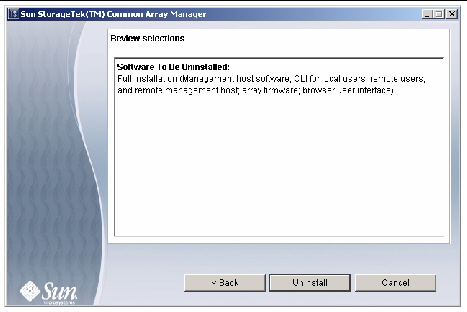
The Review Selections window is displayed.
5. Select the software to be uninstalled, and click the Uninstall button.
When the uninstall completes, the View Results screen is displayed.

1. Log in to the management host as root.
2. Change to the bin directory in the installation directory as described in Locating Files and Logs.
cd /var/opt/CommonArrayManager/Host_Software_6.x.x.x/bin
3. Execute the uninstall command
4. Follow the prompts in the install console dialog.
If for any reason the uninstallation has failed, run the uninstall script with the -f option:
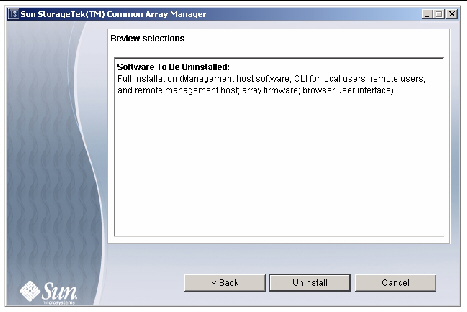
The Review Selections window is displayed.
6. Select the software to be uninstalled, and click the Uninstall button.
When the uninstall completes, the View Results screen is displayed.

| Note - Before you uninstall CAM from a Windows platform, stop all applications that are running a java.exe or javaw.exe process. |
1. Navigate to the host DVD bin directory:
<system drive>:\Sun\CommonArrayManager\Host_Software_6.x.x.x\bin
2. Click on the uninstall.bat icon.
To run the uninstaller in console mode, enter: uninstall.bat -c
To clean up (remove all associated files), enter: uninstall.bat -f
Alternatively, you can remove the Common Array Manager using the Control Panel - Add/Remove Programs.
3. Follow the uninstall wizard steps as described in the To Uninstall the Management Software on Solaris OS or Linux Using the Uninstall GUI.
| Note - Users must stop all applications that are running a java.exe or javaw.exe before running the uninstaller. |
1. Log in to the CLI on the management host or using the remote CLI client.
Navigate to the appropriate directory for your operating system:
%systemdrive%\Sun\CommonArrayManager\Host_Software_6.x.x.xx\bin\uninstall.bat
For Solaris and Linux, navigate to:
/var/opt/CommonArrayManager/Host_Software_6.x.x.xx/bin/uninstall
For the Suse 9 platform, CLI uninstall requires the following rpm packages:
2. Use the following commands to remove the current installation, removing stored data:
Perform a full uninstall, with a prompt asking if you want to remove stored data.
Perform a full uninstall in “silent” mode that removes all stored data and asks no questions.
You can verify the installation by bringing up the CLI prompt, as discussed in Logging In and Out Using the CLI.
Review the installation logs as noted in Reviewing the Installation Logs
Copyright © 2009 Sun Microsystems, Inc. All rights reserved.